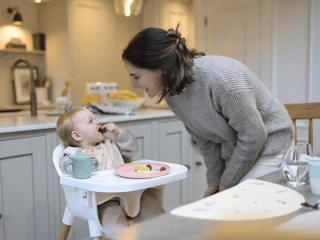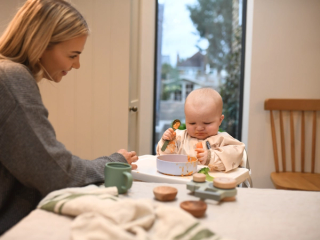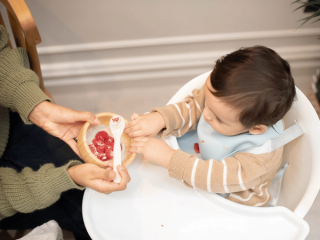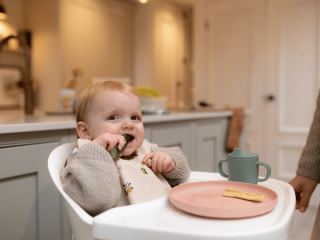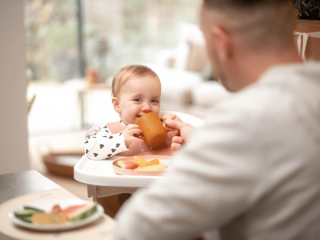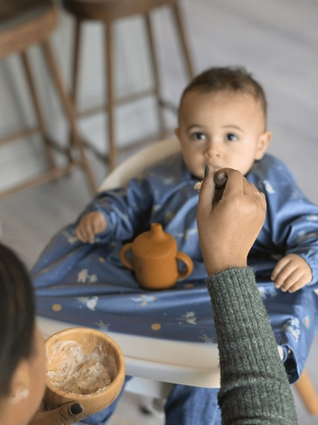
- Home
- Advice Hub
- Baby
- Weaning
- Moving Through Textures
Knowing when to move through textures
Understanding what to do is less about dates and more about understanding what to look for and how to create the right environment for learning.
Before you start weaning it can feel like there are so many questions! When to start, what foods to give, what equipment do I need?! Once you get started, one of the main questions and areas of confusion is around when to move on from puree and when to keep increasing the texture in the food.
Understanding what to do is less about dates and more about understanding what to look for and how to create the right environment for learning.
Babies are born with a suck reflex, to help them remove milk from a breast or a bottle. So, when you first offer food, you may notice foods being slurped off the spoon, or being pushed back out of the mouth with their tongue, as they haven’t yet learnt how to eat - which can be a huge learning curve!
Even with puree there is lots to learn: taking food from the spoon, closing the lips and then using the tongue, cheeks and roof of the mouth to move food around and swallow. It may take a couple of weeks or more to learn to do this. Once your baby is taking the food off the spoon with their lips, swallowing easily then leaning forward with an open mouth for more food you can start to think about moving on from initial purees.
In general, moving on through textures should be led by your baby’s ability rather than age, so try to avoid comparing to other babies as they all master new skills at different times. Some will move through textures quickly whilst others will take longer, just as they will with other developmental milestones like learning to crawl or talk.
The only timeframe you should keep in mind is moving on from smooth purees by 9 months of age. This is because there may be an increased risk of difficulty with eating textured food and fussy eating later in childhood if purees are given for too long.
What are the different stages that you should be aware of?
- Stage 1: purees and mashed foods
- Stage 2: mashed foods with soft lumps
- Stage 3: minced and chopped foods
Moving through stages works best if you change food gradually instead of sudden jumps in texture. There are different ways to do this; with purees you can make them thicker or stop blending and offer mashed instead. Alternatively you could start to add some very small grains or mashed vegetables into purees.
Once mashed foods have been mastered you can move onto minced textures. These are the types of foods that don’t need chewing, but you can’t just swallow them either. Think about foods like Bolognese sauce – you don’t need to bite it but you need to turn it into a ball of food that you put to the back of your tongue before swallowing. This might not make sense right now, but next time you eat it you’ll probably see what we mean!
Chopped foods are exactly what they sound like, foods that have been chopped. These foods should still be soft and should be chopped small enough that if they are swallowed without chewing they can still be swallowed with ease . Soft, well cooked pasta is a good example.
Our top tips when progressing through textures:
- Sit and eat with your baby – it will help them to learn if you make exaggerated chewing movements so that they can see what you’re doing and mimic your actions.
- Stay calm at mealtimes – even if you are feeling anxious, try to keep it contained! If you are watching like a hawk or jumping in to assist every time your baby gags you may create anxiety and negatively affect your baby’s eating.
- If your baby gags and spits food out or even just swallows it back down again you don’t need to worry.
- Make sure you have completed a first aid training course. It is important that you know the difference between gagging and chokingso you are confident in when you need to intervene and when you should leave your baby to get on with it. Of course if your baby does choke, it’s vital you know what to do .
- If your baby finds texture more difficult than puree avoid the temptation to stay on puree for longer. Carry on offering the new food and they will adjust to the new sensations in their mouth, learn what to do, and learn to enjoy it.
Advice & tips

Want to read more? Join the HiPP BabyClub for full access to this article.
As a BabyClub member, you'll get access to a range of exclusive benefits, including:
Monthly competitions
Discounts from our Partners
Expert advice tailored to your little one's age
Weaning recipes
HiPP shop discounts*
*10% off HiPP's online shop does not apply to our First Infant, Anti-Reflux or Comfort Formula Milk.
Important notice: Breastfeeding is best. Follow on milk should only be used as part of a mixed diet from 6 months. Talk to a healthcare professional.




